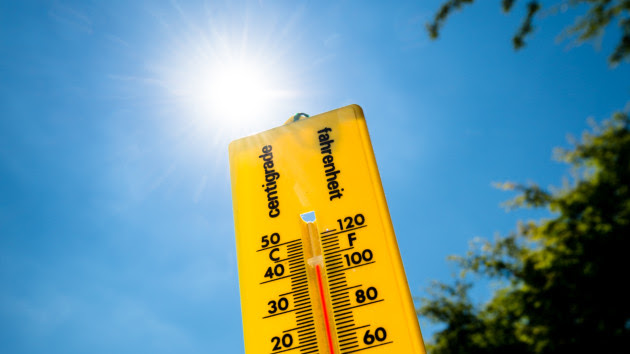(NEW YORK) — The stretch of Earth’s record-breaking global temperatures continues as the planet experiences its 10th consecutive record-breaking month.
March 2024 continues the sequence of climate records toppling for both air temperature and ocean surface temperatures, with the 10th consecutive record-breaking month, according to a new report from Copernicus, Europe’s climate change service, released on Tuesday.
Last month saw an average surface air temperature of 14.14 degrees Celsius, or 57.45 degrees Fahrenheit — .73 degrees Celsius (or 1.31 degrees Fahrenheit) — above the 1991 to 2020 average for March. Average surface air temperatures were .10 degrees Celsius, or .18 degrees Fahrenheit, above the previous warmest March in 2016.
April 2023 through March 2024 was the warmest 12-month stretch on record with a global average temperature 1.58 degrees Celsius or 2.84 degrees Fahrenheit above the 1850 to 1900 pre-industrial average.
Global sea surface temperatures across a majority of the world’s oceans remain at unprecedented levels in March 2024, the report found.
The Paris Agreement goals aim to limit global warming to 1.5 degrees Celsius higher than pre-industrial levels, or the average between 1850 and 1900. The threshold is an important signal that those higher averages are likely to happen in the next decade if emissions aren’t reduced significantly, experts say.
The new report comes as the world prepares to celebrate Earth Day later this month. As global temperatures continue to set records, here are three things you can do to help the planet by taking an active role in reducing greenhouse gas emissions and curbing the persistent global warming trend:
Plant trees and other greenery
Trees and other plants, such as bushes, shrubs and tall grasses, help cool the environment by providing shade and cooling through evaporation and transpiration, according to the Environmental Protection Agency (EPA).
In cities, urban heat islands occur when natural land cover is replaced with dense concentrations of pavement, buildings and other surfaces that absorb and retain heat. Urban areas with more forests have temperatures that are on average 2.9 degrees Fahrenheit lower than those with little vegetation, according to the latest research.
To help combat urban heat islands, the EPA says that trees and vegetation are a simple and effective way to reduce the effects. When planted in strategic locations around buildings or to shade pavement in parking lots and on streets, they can be a very effective mitigation strategy.
Reduce food waste
A report released in March by the United Nations Environment Programme found that in 2022, the world wasted 1.05 billion metric tons of food. Most of the world’s food waste came from households, accounting for approximately 60% of the total global food waste that year.
In the U.S., food is the single most common material sent to landfills, encompassing more than 24% of municipal solid waste, according to the EPA. Methane, a powerful greenhouse gas that contributes to global warming, is released in landfills.
Composting can be a simple, but impactful alternative to dispose unwanted food instead of sending it to a local landfill. You can start with a simple backyard compost pile consisting of food scraps, dry leaves and woody material from your yard.
Conserve energy
Global energy-related CO2 emissions grew by 1.1% in 2023, reaching a new record high of 37.4 billion metric tons, an increase of 410 million metric tons from the previous year. Emissions from coal accounted for more than 65% of the increase in 2023, according to an International Energy Agency report released in March.
The report highlights that clean energy is playing a major role in this slowdown and having a significant impact on the trajectory of global energy-related carbon dioxide emissions. Over the last decade, global CO2 energy-related emissions have grown by slightly more than 0.5% per year, this is the slowest rate since the Great Depression.
The EPA says you can reduce energy waste by purchasing Energy Star rated products when shopping for new appliances. You can also consider switching to cleaner energy sources, like installing solar panels on the roof of your home, purchasing a hybrid or electric vehicle, and choosing mass transit when possible.
Since 2019, the emissions growth would have been three times larger without the expansion of five key clean energy technologies, including electric cars, wind, solar PV, nuclear and heat pumps.
Copyright © 2024, ABC Audio. All rights reserved.












